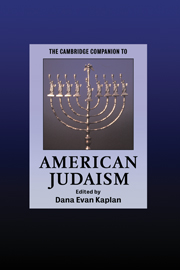Book contents
- Frontmatter
- Introduction
- Part I Historical overviews
- Part II Themes and concepts
- Section 1 Religious Culture and Institutional Practice
- Section 2 Identity and Community
- Section 3 Living in America
- Section 4 Jewish Art in America
- 20 American midrash
- 21 Recent trends in new American Jewish music
- 22 The visual arts in the American Jewish experience
- Section 5 The Future
- Afterword
- Further reading
- Index
- Series list
22 - The visual arts in the American Jewish experience
from Section 4 - Jewish Art in America
Published online by Cambridge University Press: 28 May 2006
- Frontmatter
- Introduction
- Part I Historical overviews
- Part II Themes and concepts
- Section 1 Religious Culture and Institutional Practice
- Section 2 Identity and Community
- Section 3 Living in America
- Section 4 Jewish Art in America
- 20 American midrash
- 21 Recent trends in new American Jewish music
- 22 The visual arts in the American Jewish experience
- Section 5 The Future
- Afterword
- Further reading
- Index
- Series list
Summary
Many have pondered if there is any such thing as Jewish art, while others have wondered if there is any such thing as Jewish American art. In fact, critics and historians in America have tried to describe the nature of Jewish art for decades. While Jewish artists have acknowledged that aspects of their cultural and religious experiences and backgrounds as Jews inspired them and their art, most have refused to admit that there is something called Jewish art. Even though many American artists were and are Jewish, virtually all of them have denied the label of Jewish artist. Thus, by the artists’ very standards, neither Jewish art nor Jewish American art can be said to truly exist. Nevertheless, discernibly Jewish works have been called an art done by any Jew, an art with Jewish subject matter, as well as an art that applies only to liturgical objects. In addition, it has been considered to be overly intellectual, overly emotional, and given predominantly to abstract or figurative formulations. Some had contended that true Jewish art would ultimately make its appearance either once Jewish artists were properly supported or in a Jewish national state, in reference to Israel. However, the former never truly occurred and the latter would lead to an Israeli, but not a specifically Jewish, art. Nevertheless, one commonality of so-called Jewish art currently exists: Virtually all assessments of it encompass only ancient and modern works, sidestepping the multitude of intervening works that held any Jewish content and affected both its audience and creator in the process.
- Type
- Chapter
- Information
- The Cambridge Companion to American Judaism , pp. 381 - 396Publisher: Cambridge University PressPrint publication year: 2005

